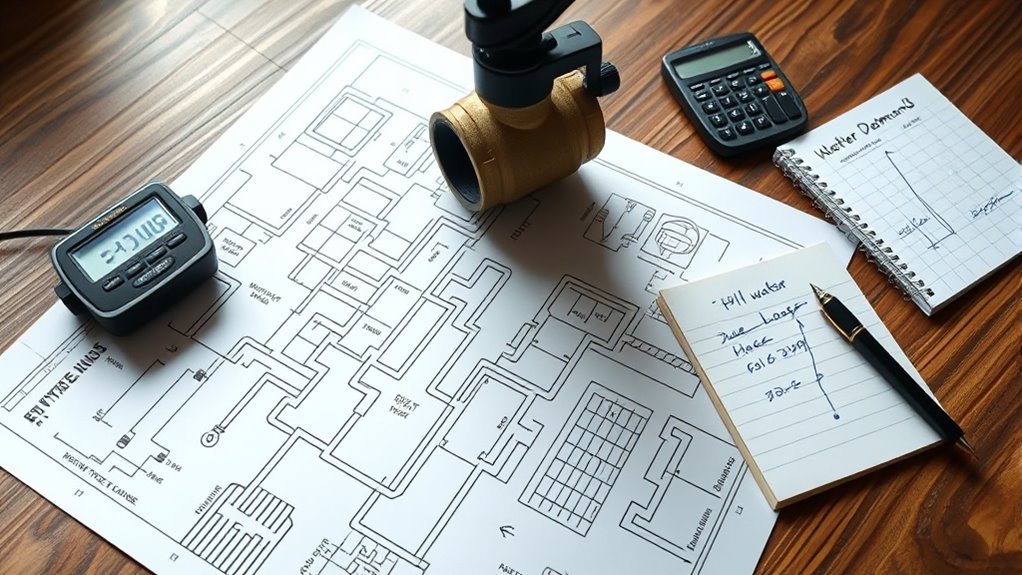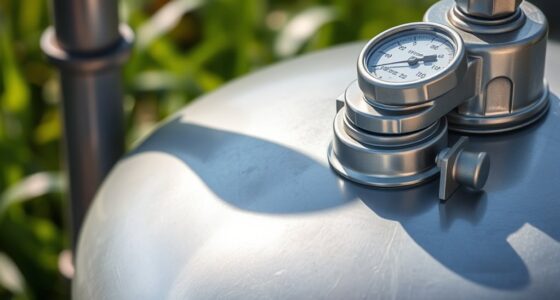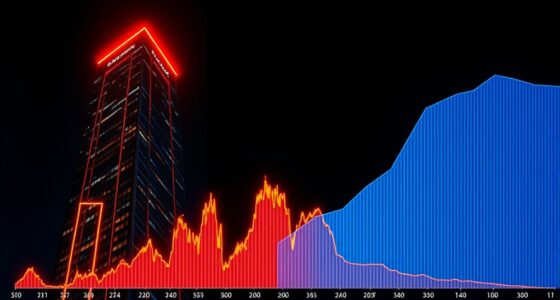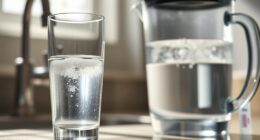To calculate your home’s peak water demand, list all fixtures like showers, toilets, and appliances, then find their flow rates—usually given in GPM or GPF. Estimate how many fixtures are used simultaneously during busy times, and multiply each fixture’s flow rate by that number. Add these amounts together, then include a safety margin of 10-20% to cover extra usage. Keep going to discover how to refine these calculations for your household.
Key Takeaways
- Inventory all household fixtures and note their flow rates (GPM or GPF).
- Identify peak usage periods and estimate the number of fixtures used simultaneously.
- Calculate total flow by multiplying each fixture’s flow rate by its maximum concurrent usage.
- Add a safety margin of 10-20% to account for unexpected simultaneous demands.
- Use the final peak demand figure to size piping, pumps, and overall water system capacity.
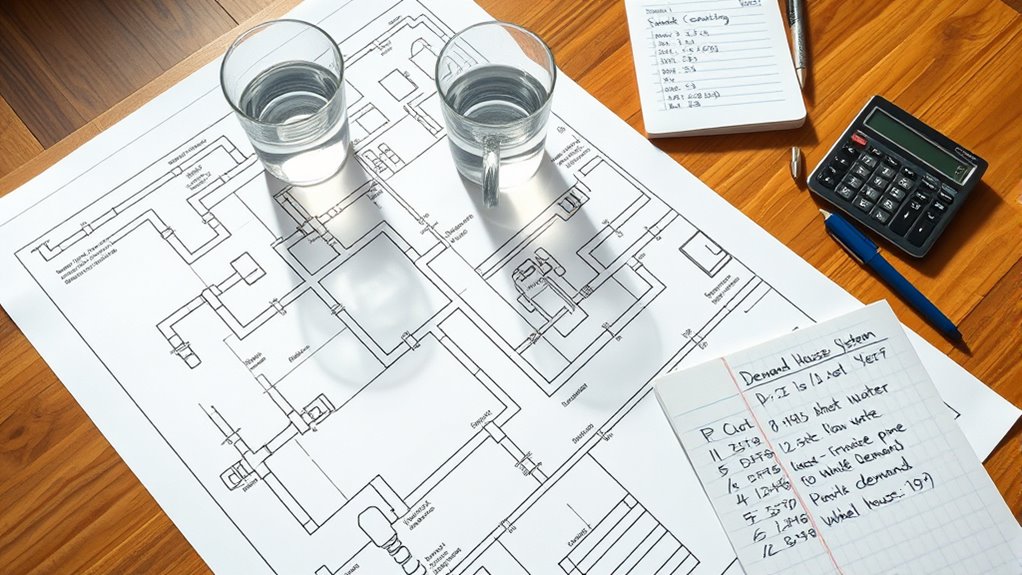
Understanding how to accurately calculate peak water demand is essential for designing efficient water supply systems. When planning for a whole house system, knowing how much water you’ll need at the busiest times helps prevent shortages and ensures smooth operation. To do this effectively, you need to consider water consumption patterns, which are the typical ways your household uses water throughout the day, and fixture flow rates, which specify how much water each fixture uses per minute. Recognizing these factors allows you to estimate the maximum flow your system must handle.
Start by listing all the fixtures in your house—faucets, showers, toilets, washing machines, dishwashers—then find their flow rates, usually expressed in gallons per minute (GPM). Fixture flow rates are often provided by manufacturers, or you can look them up. For example, a standard showerhead might have a flow rate of 2.5 GPM, while a toilet might use 1.6 GPF (gallons per flush). Knowing these rates helps you calculate each fixture’s contribution to overall demand during peak usage.
List all household fixtures and their flow rates to estimate peak water demand accurately.
Next, analyze your household’s water consumption patterns. Consider when multiple fixtures are likely to be used simultaneously. For instance, mornings often involve showers, toilets, and kitchen faucets running at once. In the evening, dishwashers and laundry might run together. By estimating these peak periods, you can identify the maximum number of fixtures in use concurrently. Suppose during peak mornings, three bathrooms are used simultaneously, along with the kitchen sink. You would then sum the flow rates of all these fixtures to find the total peak demand.
To get a more precise estimate, multiply each fixture’s flow rate by the number of fixtures likely to operate at the same time during peak hours. For example, if three showers are used at once, each at 2.5 GPM, that totals 7.5 GPM. Add in other fixtures like toilets and sinks, using their flow rates, to find the total peak water demand in gallons per minute. Remember, this is an estimate based on typical usage, so it’s wise to add a safety margin—often 10-20%—to account for unexpected simultaneous usage or variations in household habits.
Frequently Asked Questions
How Does Household Size Affect Peak Water Demand?
Your household size directly impacts peak water demand because larger families generally use more water at the same time, increasing the demand. As household size grows, water consumption during peak hours also rises, requiring a more robust system to meet these needs. Smaller households have lower peak demands, meaning their systems can be less extensive. Understanding your household size helps accurately estimate water needs and makes certain your system can handle peak usage efficiently.
What Are the Seasonal Variations in Peak Water Demand?
You’ll notice seasonal fluctuations notably impact peak water demand, especially during hot summers or cold winters. Climate impact causes increased outdoor use, like watering lawns or filling pools, raising demand. In colder months, demand shifts indoors for heating and other needs. These variations mean you should account for seasonal changes to accurately estimate and prepare for peak water demand, ensuring your system can handle the highest usage periods year-round.
How Do Different Appliance Efficiencies Impact Water Demand Calculations?
Higher appliance efficiency reduces water consumption, which lowers your peak water demand calculations. When appliances use less water, you’ll see a decrease in overall water use during peak times. To accurately estimate your demand, consider the efficiency ratings of each appliance, as more efficient models help you save water and reduce strain on your system. This leads to more precise calculations and better system design.
Can Peak Demand Estimates Change Over Time With Household Growth?
Your peak water demand estimates are like a shifting shoreline, changing with household growth over time. As urban expansion occurs and your family grows, water needs increase, making previous estimates less accurate. To keep up with water conservation goals, regularly review and adjust your demand calculations, ensuring your system efficiently meets current needs. Staying proactive helps prevent shortages and supports sustainable water use amid evolving household dynamics.
What Are Common Mistakes to Avoid in Peak Water Demand Calculations?
Avoid common mistakes like neglecting irrigation scheduling and outdoor fixtures, which can skew peak water demand calculations. You might overestimate demand if you ignore seasonal variations or assume constant usage. Make sure you accurately account for outdoor water needs during peak times and consider fluctuations in household activity. By doing so, your estimates become more reliable, helping you plan effectively and prevent water shortages during high-demand periods.
Conclusion
By understanding how to calculate peak water demand, you can guarantee your whole house system is ready to meet daily needs. Picture your pipes as a bustling river, flowing smoothly during busy mornings and quiet evenings. When you accurately gauge the maximum flow, you prevent bottlenecks and water shortages. With this knowledge, your home’s water system becomes a well-orchestrated dance, seamlessly supporting every shower, dish, and drip—keeping your household flowing effortlessly no matter the time of day.
